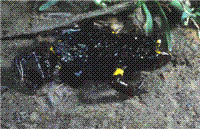Family
HylidaeGenus
PsuedophryneSpecies
dendyiThreats/Control Methods - Regional
Threatening processes are thought to include habitat modification and loss, and potentially diseases such as Chyrtrid fungus.
Chytrid Fungus is thought to have played a large role in the decline of the species and other populations of frog species are also thought to be vulnerable to its spread. For this reason care must be taken at all times when entering frog habitats, as the fungus can be spread through mud or water. To prevent the spread of the Chytrid fungus it is important to wash your shoes before entering and after leaving frog habitats. For more information on the Chytrid fungus © Link to fact sheet http://www.deh.gov.au/biodiversity/invasive/publications/c-disease/
Frogs drink and breathe through their skin and are very sensitive to chemicals in their environment. Where possible, you should not handle frogs, as the natural bacteria on your hands or chemicals such as sunscreen can damage their skin and cause illness or death.
Local/Urban Actions
None directly aimed at the species. General monitoring of frog populations in the ACT is done yearly through the Frogwatch Program. The Frogwatch program provides training for community volunteers each October, with monitoring then being undertaken by volunteers over a two week period. For more information on Frogwatch contact: The ACT Frogwatch Coordinator, Ginninderra Catchment Group; Ph(02)62783309 or email: [email protected]
Distinguishing Features
A small, 3.5cm, frog. The skin on the back is a darkbrown-lack colour, with a rough wartish appearance on the back. Bright yellow markings are found on the bottom, the forehead (sometimes) and the upper forearms, the belly has black and white marbling. The distinctive markings make this species distinctive although the call described as a nasal ©erk©, very similar to that of the Brown Toadlet (P. bibroni).
Common name/s
Southern Toadlet, Dendy©s Toadlet.
Similar Species
Northern Corroboree frog (Pseudophyrne pengilleyi), Brown Toadlet (Pseudophyrne bibroni), Southern Corroboree frog (Pseudophryne corroboree).
Distribution
The South-East corner of Australia, just overlapping the NSW and Victorian borders.
Country of Origin
Australia
Conservation (Pet/Pest) Status - National
Not currently classified as at risk.
Conservation (Pet/Pest) Status - Regional
Not currently classified as at risk.
LSCCES Population
Still thought to be common in some habitats just east of Cooma and Braidwood.
Associated Vegetation Community
forest, heathland and grassland
Limiting Resources
Requires rainfall in order to flood breeding burrows, allowing eggs to hatch and tadpoles to reach more permanent water sources.
Breeding
Calls from December to April. Eggs are laid within breeding burrows, only hatching after burrows have been flooded with water and tadpoles can disperse.
Behaviour
Males call from burrows, in order to attract females. A combination of three calls, advertisement, courtship and threat, are used to communicate with other frogs.
Functional Group
Insectivore
Food Species
Springtails (Collembola), beetles (Coleoptera), ants (Formicidae) and millipedes (Diplopoda) make up a substantial portion of their diet.
Interesting Fact
Many behavioural aspects of Dendy©s Toadlet are similar to those of the Corroboree Frogs, (P. pengilleyi) and (P. corroboree), so similar that it has been thought that there is some understanding of threat calls across the three different species.
References - (reader suitability of references, P=Primary teachers, S=Secondary students, T=Tertiary students and researchers)
Journals:
Pengilley, R.(1971) . Calling and associated behaviour of some species of Pseudophryne (Anura: Leptodactylidae). J,Zool.,Lond. 163:73-92
Pengilley, R. (1971). The food of some Australian anurans (Amphibia).J,Zool., Lond.163:93-103.
Robinson, M. (2002). A field Guide to Frogs of Australia: From Port Augusta to Fraser Island Including Tasmania. Reed New Holland/Australian Museum. Sydney, Australia.
Books:
Lintermans, M. & Osborne,W. (2002). Wet & Wild: A Field Guide to the Freshwater Animals of the Southern Tablelands and High Country of the ACT and NSW. Environment ACT. Canberra, Australia.
Researcher: Pippa Jaminon

 Top
Top Top
Top